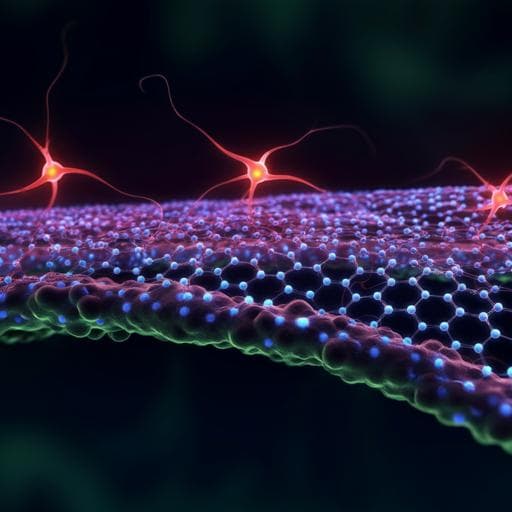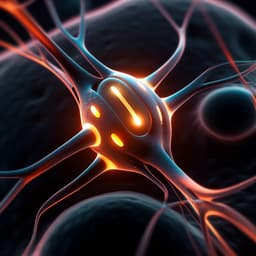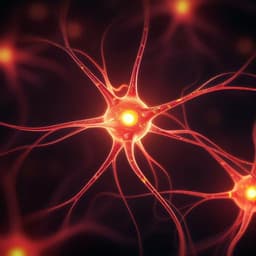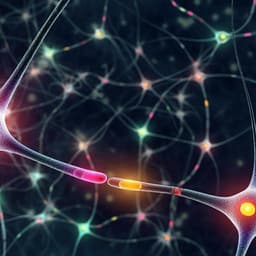
Medicine and Health
Nanoporous graphene-based thin-film microelectrodes for in vivo high-resolution neural recording and stimulation
D. Viana, S. T. Walston, et al.
Discover cutting-edge advancements in flexible neural interfaces with our innovative nanoporous graphene-based technology. This groundbreaking research led by a team from the Catalan Institute of Nanoscience and Nanotechnology and other esteemed institutions demonstrates exceptional recording fidelity and biocompatibility in chronic studies.
~3 min • Beginner • English
Introduction
Neural interface devices can treat neurological disorders but require improved efficacy to expand clinical use. Performance depends critically on the electrode material, which must satisfy stringent electrical, electrochemical, mechanical, biological, and fabrication constraints. Miniaturizing electrodes to micrometre scale is expected to enhance spatial resolution of recordings and improve stimulation selectivity and focality. Conventional noble metal electrodes and alternative materials (nanoengineered metals, metal oxides, conducting polymers, carbon-based materials) have been explored, yet challenges remain for miniaturized, chronically stable interfaces. Graphene-based materials offer a wide electrochemical window, capacitive coupling, and flexibility, but single-layer graphene has limited electrochemical performance, constraining miniaturization. Porous multilayer graphene structures could improve performance, but achieving high porosity with dense packing and high ion-accessible surface area at low transport resistance in thin films has been challenging; prior porous electrodes have been bulky, limiting integration density. The study addresses these gaps by engineering a nanoporous reduced graphene oxide thin film (EGNITE) and wafer-scale fabrication of flexible arrays to realize low-impedance, high-CIL, micrometre-scale electrodes for high-resolution recording and stimulation.
Literature Review
Prior work indicates that micrometre-scale electrodes can improve spatial resolution of neural recordings and stimulation focality. Materials explored include noble metals (gold, platinum), nanoengineered porous metals, metal oxides, conducting polymers such as PEDOT and PEDOT-CNT composites, and carbon-based materials including glassy carbon and graphene. Graphene provides a broad potential window and flexibility but single-layer devices show limited capacitance and high impedance at small scales. Previous attempts to increase charge injection and lower impedance with porous graphene improved performance but resulted in bulky (hundreds of micrometres thick) electrodes unsuitable for dense arrays. Stability of thin-film electrodes for chronic neuromodulation remains an active challenge. This work builds on these advances by producing a thin (≈1 µm) nanoporous reduced GO film integrated into flexible arrays with improved electrochemical properties and demonstrated in vivo performance.
Methodology
Material preparation: An aqueous graphene oxide (GO) solution (0.15 mg ml−1) was vacuum filtered through a 0.025 µm nitrocellulose membrane to form a thin GO film, wet-transferred onto target substrates, annealed at 100 °C for 2 min, and hydrothermally reduced at 134 °C for 3 h in an autoclave to yield EGNITE. Characterization substrates were Si/SiO2 (1×1 cm2).
Structural and chemical characterization: SEM for cross-sections; XRD (Cu Kα) to assess interlayer spacing; HRTEM/STEM-EELS to visualize stacked flakes and nanopores and quantify C/O content; AFM for surface roughness; Raman spectroscopy (488 nm) for defect density (ID/IG); XPS for surface composition changes (C/O ratio increase from 2.4 to 3.8), and electrical resistivity measurements with a Keithley sourcemeter.
Device microfabrication: Wafer-scale fabrication on 4-inch Si/SiO2 with polyimide (PI-2611) as substrate/insulation. Process: 10 µm PI spin coat and cure; pattern Ti/Au (20/200 nm) interconnects by lithography and lift-off; transfer ~1 µm GO film; pattern and protect microelectrode sites with Al columns; oxygen RIE to remove GO elsewhere; remove Al; deposit 3 µm PI; open electrode sites by thick photoresist mask and oxygen RIE; define device outline; peel-off; final hydrothermal reduction at 134 °C for 3 h to form EGNITE. Resulting arrays were ~12 µm thick. Two device types: 64-ch µECoG (8×8, 300 µm pitch) and TIME with two 9-site linear rows (25 µm sites, 135 µm row spacing).
Electrochemical testing: In 1× PBS (pH 7.4) with three-electrode setup (Ag/AgCl reference, Pt counter). Preconditioning with 10,000 charge-balanced pulses (1 ms, 15 µA). CV to determine water window (−0.9 to +0.8 V vs Ag/AgCl) and CSC; EIS to estimate interfacial capacitance using equivalent circuit (R + CPE). Chronopotentiometry for polarization under biphasic current pulses (0.1–1 ms/phase) to map charge injection capacity (CIC), removing ohmic drop. Stability assessed with 100 Hz stimulation (15 µA, 1 ms/phase) over 15 million pulses, tracking 1 kHz impedance.
Mechanical robustness: Ultrasonic bath sonication at 37 kHz (15 min at 200 W, then 15 min at 300 W). Bending test over 700 µm-diameter rod to 131°; three arrays (18 electrodes each, 50 µm sites) underwent 10–20 cycles; EIS/CV measured pre/post.
In vivo epicortical recording (acute): Anaesthetized Sprague-Dawley rats; EGNITE µECoG placed over left auditory cortex with dura intact. Ground/reference pins on dura. Acoustic stimuli (clicks and tones, 5–40 kHz, 70–80 dB SPL). Signals amplified (gain 1,000), sampled at 33 kHz. Analysis: r.m.s. in >200 Hz band, spectrograms, PSD; SNR computed as 20·ln(r.m.s.(in vivo)/r.m.s.(post-mortem)) from 10 Hz to 1 kHz.
In vivo intracortical recording (chronic): Mouse prefrontal cortex implant at ~1.7 mm depth using maltose stiffener for insertion, recordings with Open Ephys at 30 kHz during auditory task. SUA extracted (450–6,000 Hz band; PCA sorting), LFPs downsampled to 1 kHz; AEP SNR from peak N1 vs baseline s.d.
In vivo peripheral nerve stimulation: TIME implanted transversely across rat sciatic nerve (peroneal and tibial fascicles). Stimulation: trains of 100 biphasic pulses, 100 µs/phase, 0–100–150 µA in 1–3 µA steps at 3 Hz. CMAPs recorded from tibialis anterior (TA), gastrocnemius (GM), and plantar interosseous (PL) with needle electrodes, amplified and band-pass filtered (3 Hz–3 kHz), digitized at 20 kHz. CMAP amplitudes normalized; selectivity index SI = nCMAP/ΣnCMAP at minimal effective current (≥5% CMAP of that muscle’s max).
Biocompatibility—cortex (chronic): Epicortical implants (EGNITE, exposed Au on PI, PI-only) in adult rats for 2, 6, 12 weeks (n=3 per group/time). Iba-1 immunohistochemistry for microglial activation with automated image analysis; ELISA (bead-based multiplex) of cytokines from implanted vs contralateral hemispheres.
Biocompatibility—peripheral nerve (chronic): Longitudinal PI strips with or without EGNITE implanted in tibial branch of sciatic nerve (n=6–8 per group). Functional tests: nerve conduction (PL CMAP), algesimetry (Von Frey), walking track (sciatic functional index). Histology at 2 and 8 weeks: Iba-1 macrophages and NF200 axons, quantifying macrophage counts and fibrous capsule thickness.
Key Findings
- EGNITE structure and chemistry: Hydrothermal reduction decreased interflake spacing from 8.1 ± 0.8 Å (GO) to 3.9 ± 0.6 Å; TEM showed stacked flakes with nanoscale pores forming capillaries; surface r.m.s. roughness ~50 nm; Raman ID/IG increased; XPS increased C/O from 2.4 to 3.8; EELS indicated ~85% C and 15% O within bulk; resistivity decreased after reduction.
- Microfabrication: High-yield flexible arrays (~12 µm thick) integrating 25 µm-diameter EGNITE microelectrodes in 64-ch µECoG and 2×9-site TIME designs.
- Electrochemical performance: Water window −0.9 to +0.8 V vs Ag/AgCl. Interfacial capacitance 13.9 mF cm−2 (≈10^4× vs single-layer graphene). Impedance at 1 kHz: 25.2 ± 0.7 kΩ (n=18) for 25 µm sites. CSC at 100 mV s−1: CCSC 45.9 ± 2.4 mC cm−2 and aCSC 34.6 ± 2.8 mC cm−2 (n=3). CIC supported charge densities up to 3–5 mC cm−2 depending on pulse width (0.1–1 ms/phase).
- Stimulation stability: Continuous pulsing at 100 Hz (15 µA, 1 ms/phase) for 15 million pulses showed stable 1 kHz impedance without structural degradation (n=3). Mechanical robustness confirmed by ultrasonication (200–300 W) with no delamination/cracking and by bending: >98 ± 3% electrodes remained functional after 10 cycles; those remained functional after 20 cycles; minor impedance changes.
- In vivo epicortical recording (acute): High-fidelity mapping of evoked LFPs and high-frequency MUA across 64 channels in rat auditory cortex, with frequency-dependent responses (≥6 kHz stronger). Intrinsic electrode noise ~2.5 µV (post-mortem), near electronics limit. SNR (in vivo vs post-mortem PSD): up to 40 dB at 10 Hz and 5 dB at 1 kHz, outperforming a commercial Pt µECoG.
- In vivo intracortical recording (chronic): AEPs recorded at 30, 60, 90 days with mean SNR >30 dB and stable N1 peaks; SUA detected at 1 month.
- In vivo peripheral nerve stimulation: TIME stimulation elicited CMAPs with thresholds as low as 15–20 µA; recruitment curves were sigmoidal. Spatial selectivity depended on electrode position: subsets (A1–A5) preferentially activated TA at lower current; others (A7–A9) favored GM/PL. Selectivity indices reached ~0.9 for TA and PL; GM selectivity <0.6, consistent with fascicular anatomy.
- Biocompatibility—cortex: No significant differences in microglial activation (Iba-1) across EGNITE, Au, and PI devices at 2, 6, 12 weeks; no fibrosis in contact area. Cytokine levels showed no significant changes between device types or vs contralateral, except transient IL-1β/IL-6/MCP-1 increases at 2–6 weeks for EGNITE and a significant IL-18 increase at 2 weeks vs contralateral that normalized by 12 weeks.
- Biocompatibility—peripheral nerve: No significant differences between EGNITE and PI-only in macrophage counts or fibrous capsule thickness at 2 and 8 weeks; both measures peaked at 2 weeks and decreased by 8 weeks. Functional assays showed no deficits or pain hypersensitivity; histology revealed numerous axons near implants, indicating limited damage.
Discussion
The study demonstrates that a thin-film nanoporous reduced GO (EGNITE) can overcome limitations of single-layer graphene and bulky porous electrodes by providing high interfacial capacitance and low impedance at micrometre-scale geometries while remaining compatible with flexible microfabrication. The resulting arrays recorded cortical LFPs and MUAs with high SNR and low intrinsic noise, enabling fine spatiotemporal mapping of brain activity. Intrafascicular stimulation with small, dense electrodes yielded low current thresholds and high selectivity for specific muscle groups, supporting precise neuromodulation. Stability under extended pulsing, sonication, and bending, together with favorable acute and chronic biocompatibility in both CNS and PNS, indicates suitability for chronic neural interfacing. These findings address the initial goal of achieving high-fidelity, high-resolution bidirectional interfacing with a material and device platform that is scalable and manufacturable, and they highlight potential impact in applications requiring precise sensing and stimulation, such as high-resolution brain mapping, closed-loop neuromodulation, and neuroprosthetic feedback.
Conclusion
EGNITE thin-film graphene-based microelectrodes combine high porosity with thin-film integration to deliver high interfacial capacitance (>10 mF cm−2), low impedance (~25 kΩ at 1 kHz for 25 µm sites), and high charge injection (3–5 mC cm−2). Flexible, high-yield arrays enabled high-fidelity cortical recordings (LFP, MUA, SUA) with strong SNR and precise, low-threshold intraneural stimulation with high selectivity. Chronic biocompatibility studies in brain and peripheral nerve showed minimal inflammatory response, no functional deficits, and comparable fibrous encapsulation to controls. The technology is scalable and compatible with wafer-level fabrication, supporting clinical translation prospects. Future work should evaluate long-term functionality in therapeutic neuromodulation settings, further optimize electrochemical performance, and address long-term device-level stability (e.g., eliminating metal back-contacts to prevent corrosion).
Limitations
- Oxygen reduction reactions and their impact on charge injection capacity were not fully resolved; additional studies are needed to quantify faradaic contributions during stimulation.
- Long-term functionality and stability in chronic therapeutic neuromodulation scenarios were not evaluated; extended in vivo studies are required.
- Potential long-term corrosion or failure modes related to metal back-contacts and encapsulation require further engineering (e.g., eliminating metal back-contacts).
- Some in vivo demonstrations (e.g., acute cortical mapping, chronic intracortical recording) were performed in limited animal numbers, which may limit generalizability and require larger cohorts for statistical validation.
Related Publications
Explore these studies to deepen your understanding of the subject.







